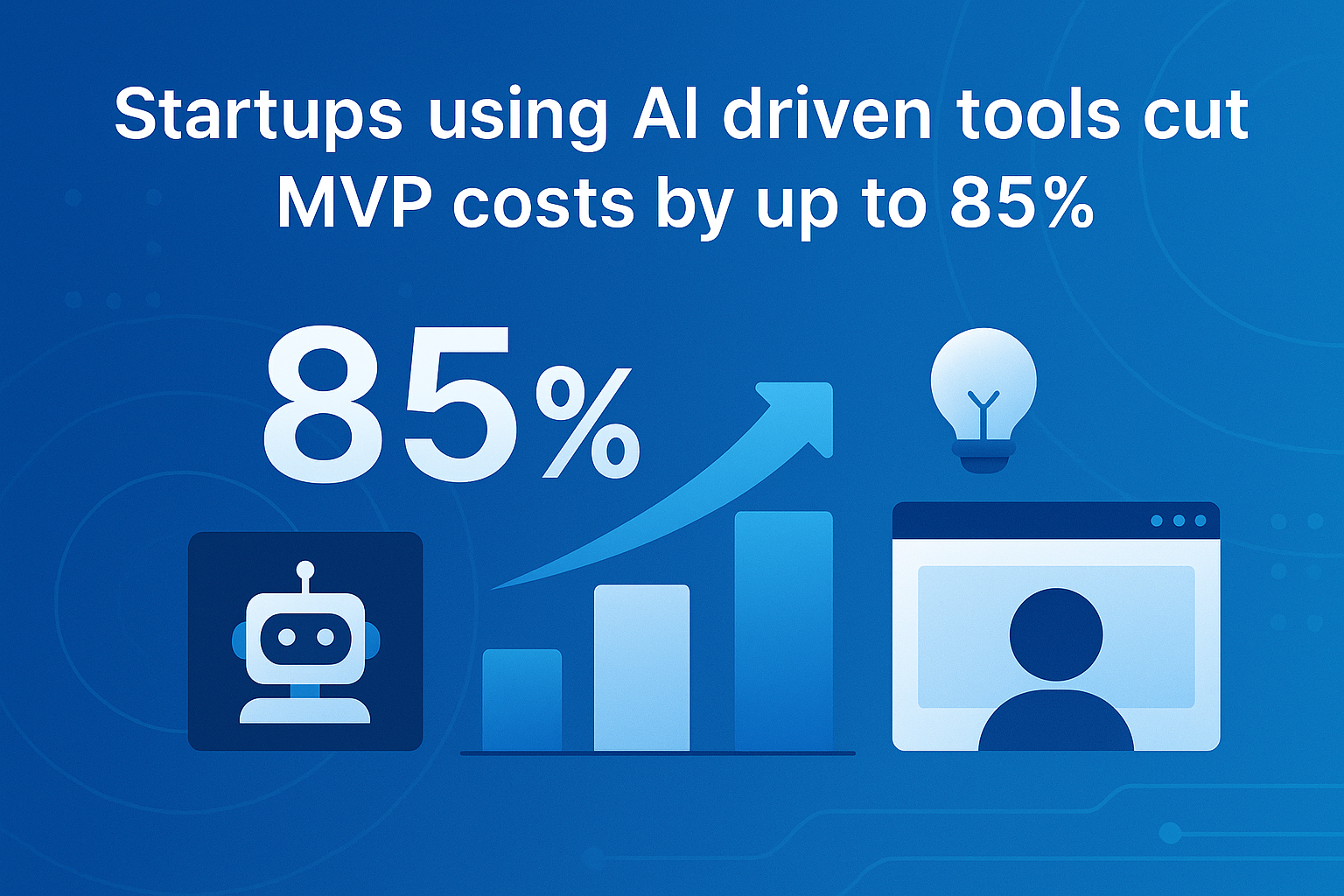Quick Summary :- Launching an AI software MVP in just 60 days is possible when you align the right idea, tech stack, distributed team and agile execution. This lead shows how to go from concept to functional MVP by working with remote experts, minimizing scope and building iteratively.
In 2025, AI product development moves fast. If you’re sitting on a promising idea to launch AI Software MVP (Minimum Viable Product) quickly is your best shot to validate it before burning time or capital. But going solo or assembling a full in-house team can be slow and expensive. The solution? A distributed team model.

Distributed development enables you to tap into global AI talent, reduce time zone bottlenecks and keep burn rates low. Startups using AI-driven tools cut MVP costs by up to 85% and launch 10x faster reducing traditional 6-month cycles to just 2-3 weeks. Combined with clear scope, lean methods and modern AI infrastructure, it’s now realistic to launch an AI MVP in just 60 days.
Pre-Launch AI MVP Checklist
Before you start the 60-day journey, make sure you have
- Clear Problem Statement – A one-sentence summary of the user pain point.
- Initial Budget Approval – Set an upper spending limit.
- Access to Relevant Data – Whether proprietary, open-source or synthetic.
- Core Team Lead Assigned – A project owner who drives decisions.
- Pre-selected Tools – Communication, version control and cloud infrastructure chosen.
Step-by-Step Guide to Launch AI Software MVP in 60 Days
Before diving into execution, clarity on your vision and constraints sets the foundation for a fast, successful AI MVP launch
Step 1 – Define a Laser Focused MVP Scope (Day 1-5)
A well-defined problem and MVP development scope are crucial for a focused and successful project launch
- Identify the core problem your AI MVP solves.
- Cut out everything that isn’t essential for the first use.
- Define 2-3 primary use cases and success metrics.
Tip – Use a value effort matrix to prioritize features.
Example – A fintech startup wants to build an AI MVP that predicts loan approval chances based on user-entered data. The MVP will only accept inputs and give a binary prediction, no dashboard or integrations yet.
Step 2 – Assemble a Distributed AI Development Team (Day 5-10)
Your distributed team should include
- Roles you’ll need AI/ML Engineer, Backend Developer, Frontend Experts, UX Designers, QA Engineers and Project Manager.
- Source globally via vetted platforms or agencies with AI expertise.
- Choose overlap-friendly time zones (e.g. India-Europe, LATAM-US).
Checklist
- Clear communication protocols (Slack, Zoom, Notion)
- Define sprint cadences and stand-up schedules
- Set KPIs and timelines from day one
Tip
Use platforms like Upwork, Toptal or Clutch to find talent or partner with a specialized AI Consulting company.
Collaboration Stack
- Notion/Confluence for documentation
- Jira/Trello for task tracking
- GitHub/GitLab for version control
- Figma for design mockups
Also Read: How to Hire a Dedicated AI Software Development Team in 2025?
Step 3 – Finalize the Tech Stack & Infrastructure (Day 10-14)
Don’t build models from scratch; use pre-trained models and APIs
- Choose Right AI stack – Python, PyTorch/TensorFlow, OpenAI APIs, Hugging Face.
- Backend – Node.js, Django or FastAPI
- Frontend – Angular, React, Next.js
- Infrastructure – AWS, Azure, Google Cloud, GitHub, Kubernetes, Docker, CI/CD
Don’t forget
- Set up logging, monitoring and repo structure early.
- Use pre-trained models to save time.
Tip – Pick a cloud provider early. Avoid switching infrastructure mid-project.
Step 4 – Build in Agile Sprints with Weekly Demos (Day 15-30)
Now that your team is assembled and initial tasks are outlined, the next step is to implement the systems and routines essential for a smooth and predictable software development process.
- Break work into 2-week sprints.
- Focus on one core feature per sprint.
- Hold weekly demos with stakeholders.
Golden Rule – Always ship something testable by the end of each sprint.
Pro Tip – Use tools like LinearB or Jira Velocity to measure progress.
Step 5 – Integrate & Test End-to-End Workflows (Day 30-45)
Clear End-to-End Workflows model impact in a different way
- Stitch together all modules (frontend and backend and AI).
- Conduct fullstack integration testing.
- Run unit tests, edge cases and user flow validations.
- Tool Suggestion Cypress, Playwright or Selenium for E2E tests.
Tip – Use lightweight frameworks like Flask or FastAPI for backend, Next.js or ReactJS for frontend.
Step 6 – Testing and Quality Assurance (Day 46-52)
Testing AI MVPs requires more than just functionality checks
- Validate prediction accuracy using confusion matrix, F1 score and precision/recall.
- Test real vs synthetic data scenarios.
- Conduct UI/UX testing with tools like Browser Stack and Playwright.
- Perform basic security checks especially for APIs.
Include usability testing Record feedback from at least 5 internal stakeholders or early users.
Also Read: Top Software Testing Trends
Step 7 – Launch Beta & Collect Feedback (Day 53-60)
Now, move to track on steps for better performance
- Release a private beta to early adopters or internal users.
- Use feedback forms, heatmaps and session replays.
- Track performance metrics and usability.
Goal – Get 15-30 meaningful user interactions within a week.
Pro Tip – Plan the next sprint cycle based on this feedback for rapid iteration.
Post Launch Roadmap From MVP to Market Fit
After your AI MVP is live, here’s how to keep momentum
- Analyze Feedback Trends – Identify the 2-3 biggest improvement requests.
- Plan the Next Feature Sprint – Focus only on high-impact changes.
- Refine Model Performance – Incrementally improve accuracy with fresh data.
- Start GTM (Go to Market) Prep – Set up early marketing campaigns and sales outreach.
- Secure Funding – Use your MVP results as proof for investors.
Accelerate Your AI MVP Journey with eSparkBiz
Share your project vision and hire AI Software Developers at eSparkBiz to design a tailored, scalable development plan. We deliver impactful AI software MVPs in just 60 days, combining speed, quality, and seamless collaboration.
Get Started Now and Transform Your Idea into Reality!
Pro Tips for Distributed AI MVP Success
These practical tips will help your distributed dedicated development team maintain momentum and avoid common pitfalls during your AI MVP build.
- Keep documentation async-friendly – Record decisions in Notion or Confluence.
- Use pre-trained AI where possible – Don’t reinvent what OpenAI or Hugging Face already offers.
- Adopt a test-driven culture – QA isn’t an afterthought, even in MVPs.
- Plan for failure early – Have rollback and recovery mechanisms.
- Set hard deadlines – Parkinson’s Law is real; work expands to fill time.
Common Challenges & Fixes
Even with a solid plan, AI MVP development often hits predictable roadblocks. Here’s how to tackle them quickly and effectively
| Challenge | Fix |
| Time zone clashes | Schedule a 2-hour overlap window daily |
| Lack of model accuracy | Use fine-tuning + smaller datasets first |
| Infrastructure complexity | Use pre-configured cloud ML pipelines (e.g. AWS JumpStart) |
| Unclear MVP goals | Write a 1-pager MVP Brief and review every 2 weeks |
Real-World Scenario: AI MVP in Weeks
Case Study – Sully.ai
- What it does Automates patient intake, triage, appointment scheduling and medical note-taking using AI-powered assistants.
- Funding Raised approximately $13–25 M during seed and Series A phases, advancing rapidly with AI-based clinical workflow automation.
Sully.ai’s success highlights how fast-tracked AI healthcare solutions can attract early funding and market validation. It reinforces the value of launching a focused AI MVP using lean, distributed teams and cloud-native tools, exactly the approach outlined in this guide.
Conclusion
You don’t need a massive budget or internal team to launch an AI MVP in 60 days. What you do need is a sharp scope, a distributed team of AI specialists and a disciplined execution plan. By focusing on iteration, leveraging existing AI tools and maintaining async clarity, you can validate ideas at speed and turn prototypes into products faster than ever.
Ready to launch your AI MVP in 60 days?
Answer a few quick questions, and our eSparkBiz experts will tailor the perfect distributed team solution for you.
-
How much does it cost to build an AI MVP in 60 days?
Expect to spend between $5,000-$60,000+ depending on complexity and team geography.
-
What if my AI model underperforms?
That’s why it’s an MVP. Validate the core approach then iterate or pivot post-launch.
-
How do I ensure code quality with a distributed team?
Ensure code quality by enforcing code reviews, using Git workflows and adopting linting + test coverage tools.
-
How do I manage security and compliance?
Use anonymized data, follow GDPR/HIPAA best practices and consult compliance experts early in the software development cycle.
-
What’s the benefit of a distributed team?
Cost efficiency, global talent access and around the clock progress if time zones are managed well.



